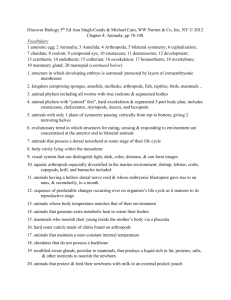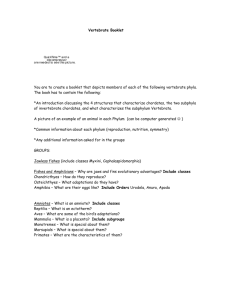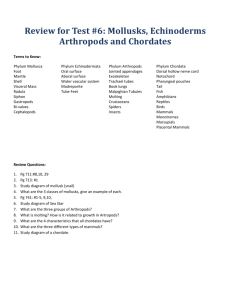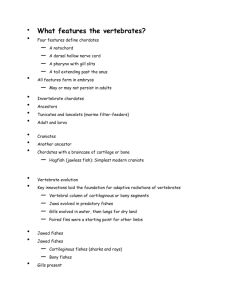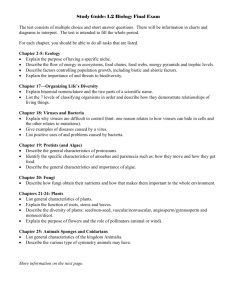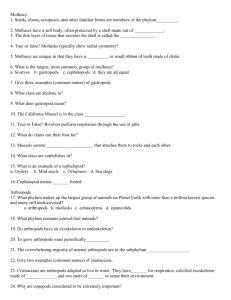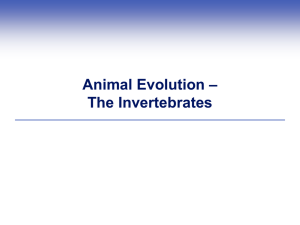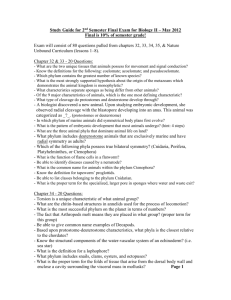CHAPTER 15: The Evolution of Microbial Life
advertisement
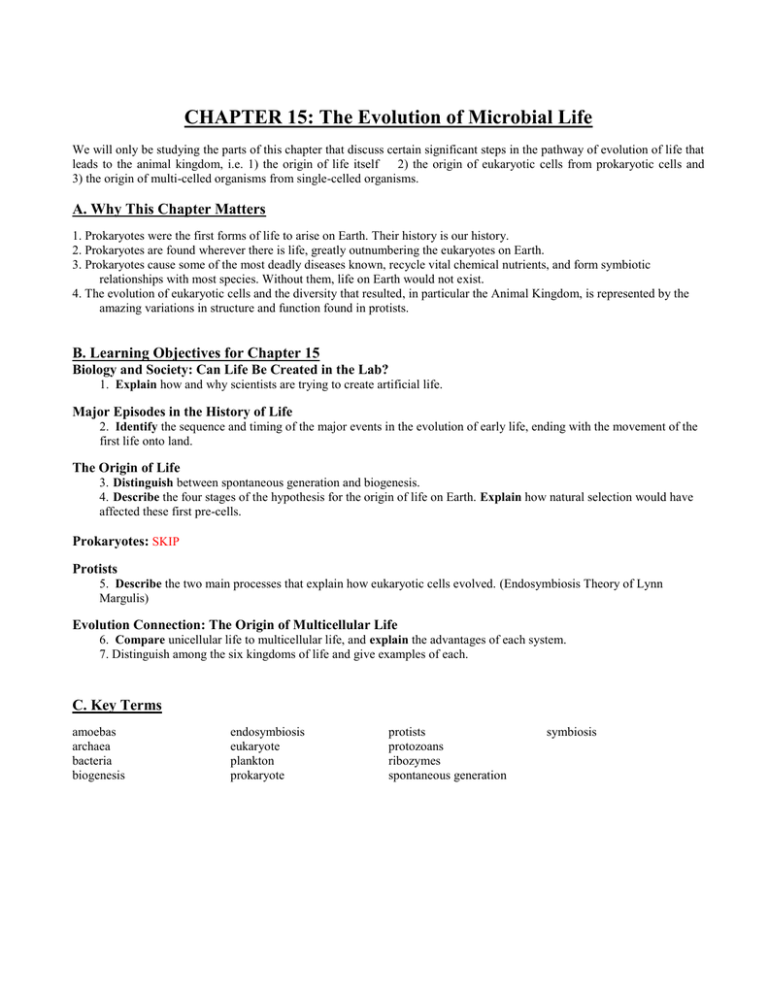
CHAPTER 15: The Evolution of Microbial Life We will only be studying the parts of this chapter that discuss certain significant steps in the pathway of evolution of life that leads to the animal kingdom, i.e. 1) the origin of life itself 2) the origin of eukaryotic cells from prokaryotic cells and 3) the origin of multi-celled organisms from single-celled organisms. A. Why This Chapter Matters 1. Prokaryotes were the first forms of life to arise on Earth. Their history is our history. 2. Prokaryotes are found wherever there is life, greatly outnumbering the eukaryotes on Earth. 3. Prokaryotes cause some of the most deadly diseases known, recycle vital chemical nutrients, and form symbiotic relationships with most species. Without them, life on Earth would not exist. 4. The evolution of eukaryotic cells and the diversity that resulted, in particular the Animal Kingdom, is represented by the amazing variations in structure and function found in protists. B. Learning Objectives for Chapter 15 Biology and Society: Can Life Be Created in the Lab? 1. Explain how and why scientists are trying to create artificial life. Major Episodes in the History of Life 2. Identify the sequence and timing of the major events in the evolution of early life, ending with the movement of the first life onto land. The Origin of Life 3. Distinguish between spontaneous generation and biogenesis. 4. Describe the four stages of the hypothesis for the origin of life on Earth. Explain how natural selection would have affected these first pre-cells. Prokaryotes: SKIP Protists 5. Describe the two main processes that explain how eukaryotic cells evolved. (Endosymbiosis Theory of Lynn Margulis) Evolution Connection: The Origin of Multicellular Life 6. Compare unicellular life to multicellular life, and explain the advantages of each system. 7. Distinguish among the six kingdoms of life and give examples of each. C. Key Terms amoebas archaea bacteria biogenesis endosymbiosis eukaryote plankton prokaryote protists protozoans ribozymes spontaneous generation symbiosis D. Word Roots archae = ancient (archaea: prokaryotic group most closely related to eukaryotes) bi = two (binary fission: a form of asexual reproduction in which a single cell divides into two cells of about equal size) bio = life; genesis = origin (biogenesis: the principle that life gives rise to life) chemo = chemical; auto = self (chemoautotrophs: organisms that need only carbon dioxide as a carbon source and extract energy from inorganic substances) endo = inner (endospores: bacterial resting cells) exo = outside (exotoxins: toxic proteins secreted by bacterial cells) flagell = a whip (flagellates: protozoa that move by means of one of more flagella) hetero = different (chemoheterotrophs: organisms that must consume organic molecules for both energy and carbon) photo = light (photoautotrophs: photosynthetic organisms, including the cyanobacteria) planktos = wandering (plankton: communities of mostly microscopic organisms that drift or swim near the water surface) protos = first; zoan = animal (protozoan: early protists that ingested food) pseudo = false; pod = foot (pseudopodia: temporary extensions of a cell used for locomotion and/or feeding) sym = together (endosymbiosis: the process whereby mitochondria and chloroplasts exist as associations between prokaryotic cells living within larger prokaryotic cells) CHAPTER 17: The Evolution of Animals A. Why This Chapter Matters 1. The lives of humans and other animals are intimately interwoven as we rely on animals as sources of food, understand animals as vectors of human disease, appreciate their roles in ecosystems, and enjoy each other in companionship. 2. Understanding the evolutionary history of animals helps us understand our evolutionary history and our place in the living world. B. Learning Objectives for Chapter 17 Charles Darwin and The Origin of Species Biology and Society: Rise of the Hobbit People 1. Describe the fossil discoveries on the Indonesian island of Flores and relate the findings to modern humans. The Origins of Animal Diversity 2. Define what it means to be an animal and describe common aspects of animal development. 3. Describe the significance of the Cambrian explosion. Describe two hypotheses that attempt to explain this major event in evolution. 4. Distinguish between the nine major animal phyla according to the presence of tissues, type of body symmetry, and presence of a body cavity. Major Invertebrate Phyla 5. Describe the body structure and feeding strategies of sponges, cnidarians, molluscs, and flatworms. 6. Describe the general structure of annelids and nematodes. Compare the lifestyles and feeding habits of earthworms, polychaetes, leeches, and nematodes. 7. Describe the general structure of arthropods, and discuss the advantages and disadvantages of an exoskeleton. 8. Distinguish between arachnids, crustaceans, millipedes, centipedes, and insects. 9. Describe the general structure of echinoderms and explain the significance of the water vascular system. Vertebrate Evolution and Diversity 10. Describe the four defining characteristics of the phylum Chordata. 11. Distinguish between the following aquatic groups: jawless vertebrates, cartilaginous fishes, ray-finned fishes, and lobe-finned fishes. Describe the significance of jaws and a swim bladder. 12. Describe several aquatic and terrestrial adaptations of amphibians. Discuss the evolution of amphibia from fish. 13. Describe the adaptations of reptiles to life on land. 14. Describe three adaptations for flight found in birds. 15. Describe the characteristics common to all mammals. Distinguish between monotremes, marsupials, and eutherian mammals, and provide examples of each. 16. Discuss the return to water by mammals seen the evolution of whales. The Human Ancestry 17. Describe the primate adaptations for living in trees. Compare the three main groups of primates, noting examples of each. 18. Compare Old World monkeys, New World monkeys, and hominoids. 19. Explain why it is incorrect (a) to consider chimpanzees as our ancestors, (b) to think of human evolution as a ladder, and (c) to think that human traits evolved together. 20. Discuss the link between humans and other great apes illustrated by human chromosome #2. 21. Describe the traits of each of the following species and the relationships between them: Australopithecus afarensis, Homo habilis, Homo erectus, Homo neanderthalensis, and Homo sapiens. 22. Explain why we think that Neanderthals had red hair and pale skin. 23.Describe the evolution of our species as we spread across the world. 24.Describe the three main stages of cultural evolution in modern humans. Evolution Connection: Recent Human Evolution 25. Explain the significance of the FOXP2 gene in humans. C. Key Terms amniotes amniotic egg amphibians animals annelids anthropoids arachnids arthropods bilateral symmetry birds bivalves blastula body cavity body segmentation bony fishes cartilaginous fishes centipedes cephalopods chordates cnidarians coelom complete digestive tract crustaceans culture dorsal, hollow nerve cord earthworms echinoderms ectotherms endoskeleton endotherms eutherians evo-devo exoskeleton flatworms gastropods gastrovascular cavity gastrula hominids hominoids insects invertebrates larva lateral line system leeches lobe-finned fishes lungfishes mammals mantle marsupials medusa metamorphosis millipedes molluscs monotremes nematodes notochord operculum pharyngeal slits placenta placental mammals polychaetes polyp post-anal tail primates pseudocoelom radial symmetry radula ray-finned fishes reptiles roundworms sponges swim bladder tetrapods vertebrates water vascular system D. Word Roots amphi = double; bio = life (amphibians: vertebrates that live life in and out of the water) annel = ring (annelids: segmented worms) anthrop = man; oid = like (anthropoid: monkeys, apes, and humans) arachn = spider (arachnids: spiders, scorpions, mites, and ticks) arthro = joint; pod = foot (Arthropoda: the phylum of animals with jointed legs) bi = double; valva = leaf of a folding door (bivalves: molluscs with two hinged shells) centi = one hundred; ped = foot (centipedes: arthropods with many legs, one pair per body segment) ceph(al) = head (cephalopods: molluscs that include octopus and squid) echino = spiny; derm = skin (Echinodermata: the phylum of sea stars, which have spiny skin) ecto = outside; therm = temperature (ectotherms: animals that absorb heat instead of producing it internally) endo = inside (endothermic: animals that produce heat internally) exo = outside (exoskeleton: an external skeleton such as that found in all arthropods) gaster = belly (gastropods: molluscs with their gut near their muscular foot) homin = man (hominids: humans and our nearest ancestors) marsupi = bag or pouch (marsupials: the pouched mammals) meta = change; morph = form (metamorphosis: a change in animal form during a lifetime) milli = one thousand (millipedes: arthropods with many legs, two pairs per body segment) mollusc = soft (Mollusca: the phylum of soft-bodied animals usually surrounded by hard shells) mono = one (monotremes: mammals that lay eggs) noto = the back; chord = string (notochord: a flexible, longitudinal rod characteristic of chordate animals) platy = flat; helminthes = a worm (Platyhelminthes: the phylum of flatworms) por = pore; fer = bearer (Porifera: the phylum of sponges) post = behind (post-anal tail: the type of tail found in chordate animals) pseudo = false (pseudocoelom: a body cavity that is not completely lined by tissue derived from mesoderm) tetra = four (tetrapods: the group of terrestrial vertebrates with four legs)
